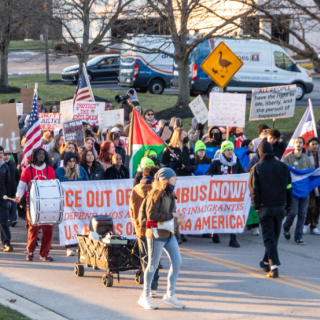Advertisement
When it comes to major road projects in Central Ohio, MORPC – the Mid-Ohio Regional Planning Commission – is a big power player. So is ODOT, of course. As Columbus and its suburbs continue to grow seemingly out-of-control, one question raised by residents is: What comes first, massive development and then surrounding road improvements, or improved roads first and then massive development?
Widening or adding lanes, for instance, before thousands move in. But there’s confusion over what comes first or what should come first. A West Side housing activist, who did want to offer their name for publication, says they heard this during an area commission meeting.
“One of the weird things I learned from MORPC is that development comes first followed by street improvements later,” said the unnamed source. “You would think that streets should be improved first but that’s not how it works in Ohio.”
When presented with this quote, MORPC spokesperson Melissa Rapp stated in an email, “That statement is not a factual statement. MORPC supports local governments with regional planning, tools, and funding but does not prescribe local policies, processes, or ordinances.”
MORPC is the U.S. Department of Transportation’s designated metropolitan planning organization (MPO) for the Columbus urban area. Rapp said MORPC “subscribes” to ODOT’s “Fix-it-First” policy, but the jurisdictional level makes decisions on road improvements. “Fix-it-First” emphasizes making steady, systematic improvements rather than waiting to make rpairs until major reconstruction is needed.
“The relationship between development and road improvement must be addressed at the jurisdictional level,” she said. “We identify where and how transportation investments occur in the region – specifically within the MPO boundary; however, it is up to the local jurisdictions to determine specifically where and which projects they request funding.”
Which raises another question: Are local jurisdictions adhering to ODOT’s “Fix-it-First,” or do they wait until the development is completed? Or do they even make the essential road improvements at all?
Hell is Route 256
No one has to tell the Far East, Reynoldsburg and Pickerington residents the Urban Sprawl nightmare that is Rt. 256. Arguably the most congested main artery in Central Ohio over the previous decade if not longer. Residents, many from nearby apartment complexes, have, for many years, waited through four cycles of red lights just to get on Rt. 256 so to access 70 West to downtown.
Absurd is how this area is not even in Franklin County, but Fairfield. Worse is how most of Route 256 is jammed with retail plazas and what could be the largest Walmart parking lot on the planet.
The City of Pickerington several years ago added a third southbound lane to a stretch of 256 considered a severe bottleneck. To make room for the new lane, over two-hundred flowering pear trees were destroyed. The Pickerington Time-Suns, a community weekly, reported the tree removal was to establish a “boulevard feel” so to allow businesses on 256 “crucial exposure” to passing motorists.
This spring, Hilliard and Far West Columbus are concerned as their farthest edges are beginning to sprout expensive homes and overpriced apartments. In a 3-mile radius, four massive developments – two in Columbus and two in Hilliard – are arising from the now long-gone soybean fields.
One of these developments is “Sugar Farms,” which will add 1,000 single-family residences, which includes several oversized bland apartment buildings. The homes are over $400,000 and the cheapest apartment is $1,500 for a two bedroom. Further proof that sprawl and density can be one-and-the-same, and that density may not be the answer to affordable housing. (As if sold-out politicians who push for more density wouldn’t pull the ole’ bait-n-switch.)
Soon hundreds of more cars, if not thousands, will be fighting to get on 70 East or 270 to head downtown on what amounts to two entry points with one lane each (the Roberts Road exit and the exit between Feder and Renner Roads).
"Columbus and the region are absolutely the worst I have ever lived in solely because of their inability or unwillingness to provide infrastructure for what’s already here and yet they keep letting developers build wherever and whatever they want,” said one Far West resident on a recent Facebook post regarding Sugar Farms.
Another post stated, “The developers and City of Columbus reap all the financial benefits, and citizens get traffic nightmares, crowded schools and loss of farmland and nature.”
Both Sugar Farms and neighboring Renner Park – the other massive Far West Side single-residence development in the works – are at this time only accessible by two roads. Each one lane out and one lane in.
The City of Columbus, MORPC and ODOT are completing a project “to improve” the intersection of Hilliard-Rome Road, Feder Road and Fisher Road “by reducing traffic congestion”, but this is the only current City of Columbus project to alleviate what could easily be the region’s next Rt. 256.
Back in April, Hilliard’s City Council approved an update to their Hilliard Comprehensive Plan, Hilliard by Design. It was last updated in 2011.
According to Hilliard by Design, Hilliard leadership is prepared to manage the growth but many residents scoff. Keep in mind a big portion of how they manage their growth is how they respond to their neighbor and big brother (the bully?) Columbus, which in 2019 annexed the land for Sugar Farms from Brown and Norwich townships.
“One of the big ideas is that we need to look more inward, than continuing annexing land and growing westward,” said Hilliard’s assistant city manager Dan Ralley in a Hilliard by Design related video.
Which is welcome news for both the Big and Little Darbys and their watershed, which is several miles west of Sugar Farms. Both have been designated national and state scenic rivers, and are some of the most ecologically diverse in the US. Home to over 100 migratory birds, 50 species of fish and 90 species of freshwater mussels, which are “canaries in the coal mine” to the health of freshwater. The Big Darby had a large mussel die-off in 2016 and to this day no one knows why.
The Washington DC-based nonprofit American Rivers in 2019 named the Big Darby one of its most endangered rivers citing “Reckless Development” as its greatest threat.
The Big Darby Watershed Master Plan, which is strictly policy and not law, was established in 2008 by nine jurisdictions, including Columbus and Hilliard. According to Hilliard by Design, this Master Plan calls for a conservation growth pattern in which at least 50 percent of every development would be preserved as open space, and gross density would be limited to one dwelling unit per acre.
Sugar Farms is nowhere near 50 percent open space and was approved by Columbus City Council to have three units per acre.
Kelley Arnold, the Far West Side Area Commission’s zoning chair, perhaps explains it best why in the near future we may see mixed-use development near the banks of the Big Darby.
“The Big Darby Accord (and those on its panel) had their say, (but) that say was not strong enough,” says Arnold. “The whole process can easily be exploited. Because it involves many different panels and City departments, and they’ve been doing this for decades. They know how to work this process. Whereas residents, including people like ourselves on this commission, have that challenge of being outside this process.”



